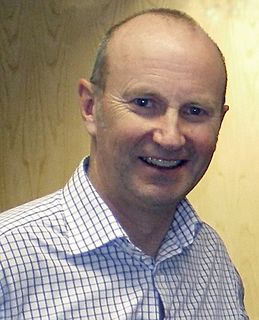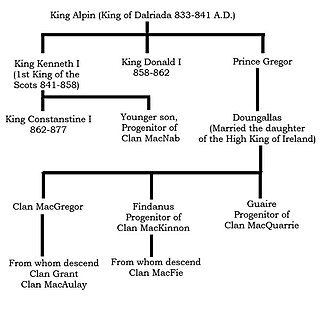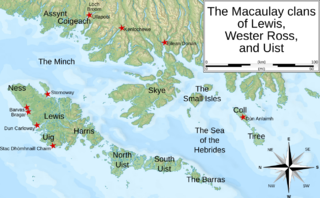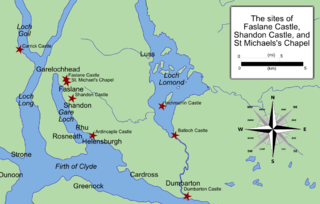Olaf or Olav is a Norwegian and Danish given name. It is presumably of Proto-Norse origin, reconstructed as *Anu-laibaz, from anu "ancestor, grand-father" and laibaz "heirloom, descendant".
Old English forms are attested as Ǣlāf, Anlāf. The corresponding Old Novgorod dialect form is Uleb. A later English form of the name is Olave.
Macaulay, Macauley, MacAulay, or McAulay may refer to:

Uig, also known as Sgìr' Ùig, is a civil parish and community in the west of the island of Lewis in the Outer Hebrides, Scotland. The Parish of Uig is one of the four civil parishes of the Isle of Lewis. It contains the districts of Carloway, East Uig, Bernera and West Uig. The name derives from the Norse word Vik meaning 'a bay'.
John Macaulay may refer to:

Frederick MacAulay is a Scottish comedian. For 18 years, until March 2015, he presented a daily BBC Scotland radio programme MacAulay and Co. He has appeared on numerous TV shows.

Clan MacAlister is a Scottish Clan and a branch of Clan Donald. The clan is the earliest branch to have split off from Clan Donald, claiming descent from Alasdair Mòr, son of Domhnall founder of Clan Donald. From Alasdair Mòr the clans takes its surname MacAlister; this surname is an Anglicisation of the Gaelic MacAlasdair meaning "son of Alasdair". In the 15th century the chief of the clan was seated in Kintyre, and the clan was centred there until the 18th century, when a chief sold the family estate in preference to a lowland estate.

Siol Alpin is a family of seven Scottish clans able to trace their descent from Alpin, father of Cináed mac Ailpín, King of the Picts, of whom the Scots tradition considered the first King of Scots. The seven clans that make up Siol Alpin are: Clan Grant, Clan Gregor, Clan MacAulay, Clan Macfie, Clan Mackinnon, Clan Macnab, and Clan MacQuarrie.

Clan MacAulay, also spelt Macaulay or Macauley is a Scottish clan. The clan was historically centred on the lands of Ardincaple, which are today consumed by the little village of Rhu and burgh of Helensburgh in Argyll and Bute. The MacAulays of Ardincaple were located mainly in the traditional county of Dunbartonshire, which straddles the "Highland Line" between the Scottish Highlands and Lowlands. Clan MacAulay has been considered a "Highland clan" by writers and has been linked by various historians to the original Earls of Lennox and in later times to Clan Gregor. The MacAulays of Ardincaple, like Clan Gregor and several other clans, have traditionally been considered one of the seven clans which make up Siol Alpin. This group of clans were said to have claimed descent from Cináed mac Ailpín, King of the Picts, from whom later kings of Scotland traced their descent. The chiefs of Clan MacAulay were styled Laird of Ardincaple.

Clan Galbraith is a Scottish clan. The clan does not have a chief recognised by the Lord Lyon King of Arms. Because of this, the clan is considered an armigerous clan, and as such Clan Galbraith has no standing under Scots Law. The clan-name of Galbraith is of Gaelic origin, however its meaning denotes the bearer as of British origin, as opposed to Gaelic. The early Galbraiths were centred in the Lennox district, which spans the Highland and Lowland border of Scotland. The 17th chief of the clan brought ruin to the clan in the late 16th and early 17th century, and eventually lost his lands and fled Scotland for Ireland. His grandson, the 19th chief, was the last chief of Clan Galbraith.

The Battle of Bealach nam Broig was a battle fought between Scottish clans from the lands of north-west Ross, against north-eastern clans of Ross who supported the Earl of Ross. The actual date of the battle is debated, it probably occurred in 1452 but the Conflicts of the Clans suggests a date as early as 1299.

Ardencaple Castle, also known as Ardincaple Castle, and sometimes referred to as Ardencaple Castle Light, is a listed building, situated about 1 statute mile (1.6 km) from Helensburgh, Argyll and Bute, Scotland. Today, all that remains of the castle is a tower, perched on the edge of a plateau, looking down on a flat tract of land between it and the shore of the Firth of Clyde. The original castle was thought to have been built sometime in the 12th century, and part of the remains of the original castle were said to have existed in the 19th century. Today, that sole remaining tower is used as a navigational aid for shipping on the Firth of Clyde. Because of its use as a lighthouse the tower has been called Ardencaple Castle Light.

The Macaulay family of Uig in Lewis, known in Scottish Gaelic as Clann mhic Amhlaigh, were a small family located around Uig on the Isle of Lewis in the Outer Hebrides of Scotland. There is no connection between the Macaulays of Lewis and Clan MacAulay which was centred in the Loch Lomond area, bordering the Scottish Highlands and Scottish Lowlands. The Macaulays of Lewis are generally said to be of Norse origin because of the etymology of their surname and also because of the islands' Viking Age past. However, a recent analysis of the Y-DNA of men with Scottish surnames has shown that a large number of Hebridean Macaulays are of Irish origin. In the 17th century, however, tradition gave the Macaulays an Irish origin. By the end of the 16th century the dominant clan on Lewis was Clan Macleod of The Lewes. Other notable Lewis clans were the somewhat smaller Morrisons of Ness and the even less numerous Macaulays of Uig. The Macaulays were centred in the area surrounding Uig on the western coast of Lewis, and had a deadly, long-standing feud with the Morrisons, whose lands were located on the northern coast around Ness. Today the Lewis surname Macaulay is considered to be a sept name of the Macleods of Lewis. There are two other nearby clans of Macaulays who may, or may not, be connected to the Lewis clan—the Wester Ross Macaulays, and the Uist MacAulays.

Faslane Castle and Shandon Castle were two mediaeval Scottish castles which once stood between the towns Garelochhead and Helensburgh, near the shores of the Gare Loch, in Argyll and Bute. In the 19th century, the castles were thought to have dated back to the Middle Ages. At that time period, they were situated in within the mormaerdom of Lennox, which was controlled by the mormaers of Lennox. Today nothing remains of Faslane Castle; though in the 19th century certain ruins of Shandon Castle were said to have still existed. Near the site of Faslane Castle sits the ruinous St Michael's Chapel, which has also been thought to date to the Middle Ages.
Mac Amhalghaidh is an Irish masculine surname. The name translates into English as "son of Amhalghadh". The surname originated as a patronym, however it no longer refers to the actual name of the bearer's father. The form of the surname for unmarried females is Nic Amhalghaidh. The forms for married females are Bean Mhic Amhalghaidh and Mhic Amhalghaidh. The Irish Mac Amhalghaidh has numerous Anglicised forms. The surname has been borne by at least one notable Irish family.
Macaulay, Macauley, MacAulay, McAulay and McAuley are surnames in the English language. There are several etymological origins for the names: all of which originated as patronyms in several Gaelic languages—Irish and Scottish Gaelic. Although the English-language surnames are ultimately derived from Gaelic patronyms, the English-language surnames, and the modern Gaelic-language forms do not refer to the actual name of the bearer's father. In the United States, the surnames are not very common; according to census data, Macaulay and MacAulay (combined) are much more common than McAulay.

The Battle of Lagganmore took place in 1646 at Lagganmore in Glen Euchar, west of Loch Scammadale. It was part of the Scottish Civil War, though in this case the battle, which was fought largely between Highland clansmen, incorporated a long running feud between Clan MacDonald and Clan Campbell.
Before the Acts of Union 1707, the barons of the shire of Dumbarton elected commissioners to represent them in the unicameral Parliament of Scotland and in the Convention of the Estates.













